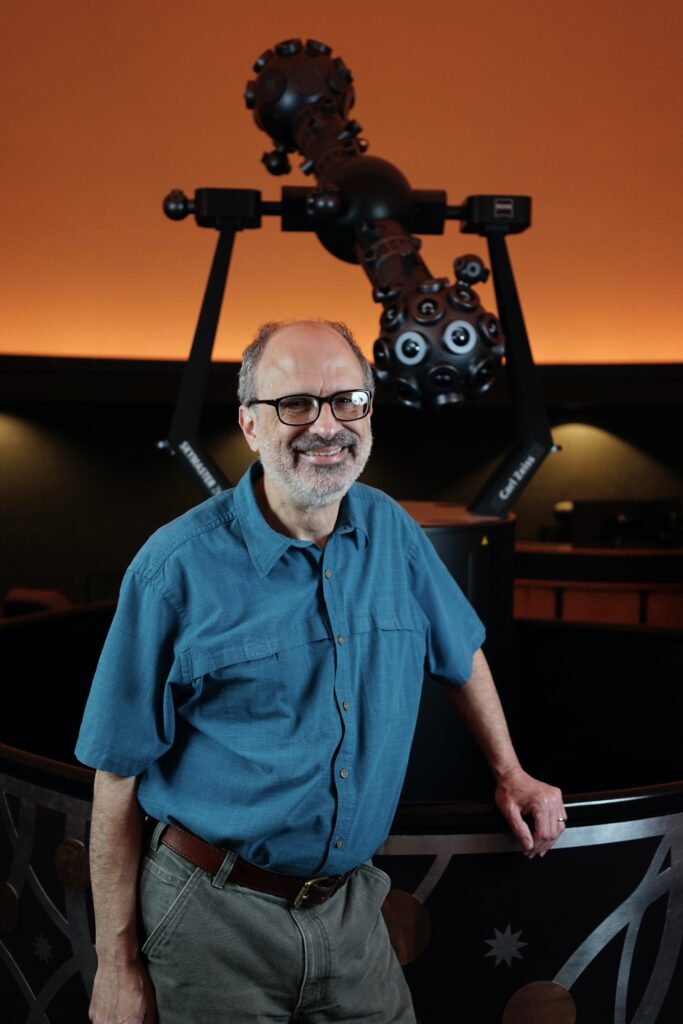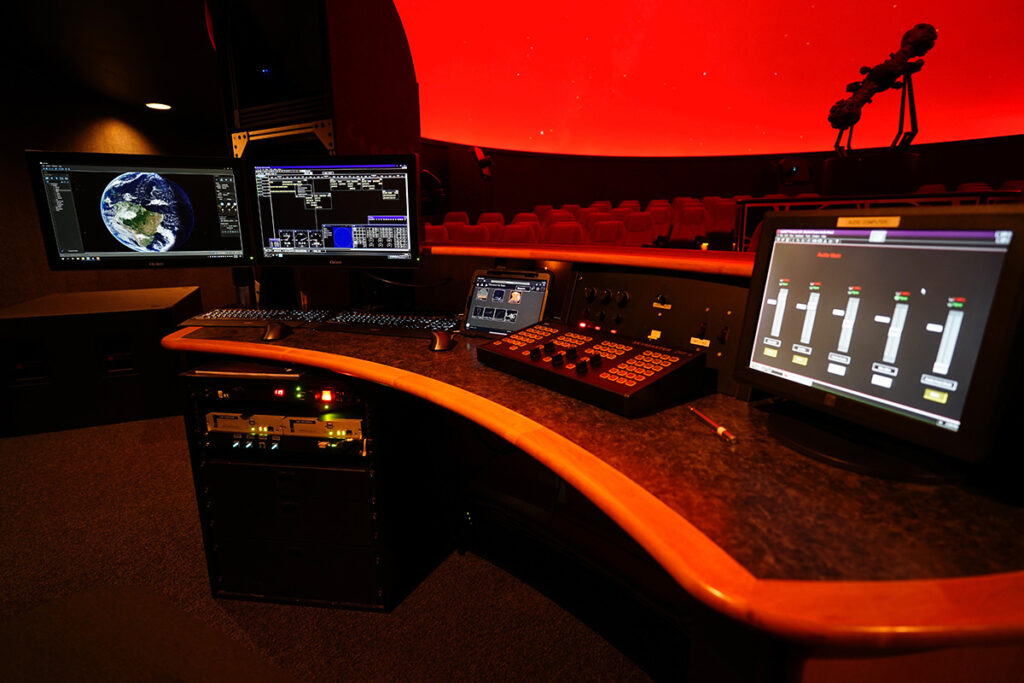

Yes, that is a bold statement. I think it’s true.
Where else can a guest explore the great outdoors at Bays Mountain and also explore another planet? Or the deepest reaches of space? Or the night sky from anywhere or any time? I could keep going, but you get the idea. The planetarium theater is a magical place. I enjoy seeing how our guests react to the theater when they first enter. It’s the same no matter if it’s a public program with mixed ages or a school group of elementary school children. They round the corner from the entrance hallway, look up and around, and say “ooh…” with a smile and an expression of wonderment. Don’t believe me? Next time you visit, watch others as they turn that corner.

And what’s that word “planetaria” in the title? It’s the plural of planetarium. I am a planetarian, one who works in a planetarium theater. The word planetarian was coined by my friend and colleague, Jim Hooks. He was the Planetarium Director at Robeson Planetarium in Lumberton, NC from 1968 to 2001. In addition to his life’s work of science education, he helped establish the Southeastern Planetarium Association around 1980. He passed away a few months ago and every time I use that term, I think of Jim.
Let’s go back to “planetaria.” These are projectors designed to recreate the night sky; a planetarium. Yes, that cool opto-mechanical device in the middle of the theater is called the planetarium. The space that includes the projector, dome, audio, seats, etc. is called a planetarium theater. Spaces designed to recreate the night sky have been around for a very long time. Why? The night sky is something that connects us all to the larger scheme of things. It is the first storybook for everyone around the world. We make pictures with the stars. It’s an innate function we have, and use, that starts soon after we are born. We want to make pictures out of seemingly random patterns. Some early star spaces were celestial globes and ceilings with a painted night sky. Some were large rooms with literal star shapes stuck to a domed ceiling, much like a child does with their glow-in-the-dark stars. But that child didn’t change the whole sky on a regular basis with workers on scaffolds to represent the Earth’s revolution around the Sun and our changing perspective of what is visible after sunset. Does yours? (If so, they may have a future career in planetaria.)
2023 to 2025 marks the centennial of the modern star projector. A modern star projector is a machine that projects the stars accurately for the entire night sky seen from anywhere on the Earth. There are motors that replicate the complex movements of the Earth; Diurnal and Precessional. There’s a motor for setting our latitude. And there’s a whole host of motors and projectors for the Sun, Moon and five other visible planets. We should also include markers that display the celestial equator and poles, the ecliptic and more. The first three motions mentioned are easy to replicate. The ones for the Solar System are very complex. The Moon is the most complex and it adds phasing. The first planetarium projector like this was from Carl Zeiss. It was first used in a test dome in Jena, Germany in 1923. The first public planetarium theater was in Munich. It opened in 1925 with a Zeiss projector.

A peek behind the curtain: Zeiss numbers specific products in numerical order, regardless of different model designs. There have been many different planetarium models made over the century but they are numbered in one order of manufacture as they are all planetaria. And yes, these machines are custom-made to order. The first one from 1923 is #1. We have a Zeiss projector, it is #601. Cool, huh?
The most recent Zeiss planetaria, like ours, use fiber optic strands to project each and every individual star. They also use stepper motors to very quickly move the machine and move from one date to another. For those of you that remember our previous star projector, it took over an hour to move the gears to shift 20 years forward or back with a machine accuracy of maybe ±50 years. Our current machine can display ±10,000 years accurately and change in seconds.
Continuing on the technical side, visitors will also see six vertical boxes around the perimeter of the theater. Those are house digital projectors that seamlessly fill the hemispherical dome with imagery. They are also from Zeiss and called VELVET LED. LED for the light source, VELVET for the true black. This is the only projector model in the world designed for the night sky. They were originally, and still are, used for Department of Defense (DOD) flight training. Flight simulators need to project an absolute black, not a grey. There’s even a version that can project imagery in IR (infrared?), so pilots can use night-vision goggles. Bragging rights alert: We have six of these projectors to provide a stunning experience. There are only a few other theaters in the world that are similar to ours, but none are the same. I think we have one of the best theaters in the world. Needless to say, guests can explore anywhere and any time.
Lastly, in the professional planetarium community, it is said that the best planetaria are so because of those in it. They bring the exploration in a fun and engaging way. They are the storytellers and the scientists. They are the artists and the educators. They are also those that turn that corner, look up and wonder about their place in the Cosmos. Yes… planetaria are very cool.

Let’s Face It… Planetaria Are Cool

By Adam Thanz, Bays Mountain Planetarium Director - Author
May 19, 2025
Yes, that is a bold statement. I think it’s true.
Where else can a guest explore the great outdoors at Bays Mountain and also explore another planet? Or the deepest reaches of space? Or the night sky from anywhere or any time? I could keep going, but you get the idea. The planetarium theater is a magical place. I enjoy seeing how our guests react to the theater when they first enter. It’s the same no matter if it’s a public program with mixed ages or a school group of elementary school children. They round the corner from the entrance hallway, look up and around, and say “ooh…” with a smile and an expression of wonderment. Don’t believe me? Next time you visit, watch others as they turn that corner.

And what’s that word “planetaria” in the title? It’s the plural of planetarium. I am a planetarian, one who works in a planetarium theater. The word planetarian was coined by my friend and colleague, Jim Hooks. He was the Planetarium Director at Robeson Planetarium in Lumberton, NC from 1968 to 2001. In addition to his life’s work of science education, he helped establish the Southeastern Planetarium Association around 1980. He passed away a few months ago and every time I use that term, I think of Jim.
Let’s go back to “planetaria.” These are projectors designed to recreate the night sky; a planetarium. Yes, that cool opto-mechanical device in the middle of the theater is called the planetarium. The space that includes the projector, dome, audio, seats, etc. is called a planetarium theater. Spaces designed to recreate the night sky have been around for a very long time. Why? The night sky is something that connects us all to the larger scheme of things. It is the first storybook for everyone around the world. We make pictures with the stars. It’s an innate function we have, and use, that starts soon after we are born. We want to make pictures out of seemingly random patterns. Some early star spaces were celestial globes and ceilings with a painted night sky. Some were large rooms with literal star shapes stuck to a domed ceiling, much like a child does with their glow-in-the-dark stars. But that child didn’t change the whole sky on a regular basis with workers on scaffolds to represent the Earth’s revolution around the Sun and our changing perspective of what is visible after sunset. Does yours? (If so, they may have a future career in planetaria.)
2023 to 2025 marks the centennial of the modern star projector. A modern star projector is a machine that projects the stars accurately for the entire night sky seen from anywhere on the Earth. There are motors that replicate the complex movements of the Earth; Diurnal and Precessional. There’s a motor for setting our latitude. And there’s a whole host of motors and projectors for the Sun, Moon and five other visible planets. We should also include markers that display the celestial equator and poles, the ecliptic and more. The first three motions mentioned are easy to replicate. The ones for the Solar System are very complex. The Moon is the most complex and it adds phasing. The first planetarium projector like this was from Carl Zeiss. It was first used in a test dome in Jena, Germany in 1923. The first public planetarium theater was in Munich. It opened in 1925 with a Zeiss projector.

A peek behind the curtain: Zeiss numbers specific products in numerical order, regardless of different model designs. There have been many different planetarium models made over the century but they are numbered in one order of manufacture as they are all planetaria. And yes, these machines are custom-made to order. The first one from 1923 is #1. We have a Zeiss projector, it is #601. Cool, huh?
The most recent Zeiss planetaria, like ours, use fiber optic strands to project each and every individual star. They also use stepper motors to very quickly move the machine and move from one date to another. For those of you that remember our previous star projector, it took over an hour to move the gears to shift 20 years forward or back with a machine accuracy of maybe ±50 years. Our current machine can display ±10,000 years accurately and change in seconds.
Continuing on the technical side, visitors will also see six vertical boxes around the perimeter of the theater. Those are house digital projectors that seamlessly fill the hemispherical dome with imagery. They are also from Zeiss and called VELVET LED. LED for the light source, VELVET for the true black. This is the only projector model in the world designed for the night sky. They were originally, and still are, used for Department of Defense (DOD) flight training. Flight simulators need to project an absolute black, not a grey. There’s even a version that can project imagery in IR (infrared?), so pilots can use night-vision goggles. Bragging rights alert: We have six of these projectors to provide a stunning experience. There are only a few other theaters in the world that are similar to ours, but none are the same. I think we have one of the best theaters in the world. Needless to say, guests can explore anywhere and any time.
Lastly, in the professional planetarium community, it is said that the best planetaria are so because of those in it. They bring the exploration in a fun and engaging way. They are the storytellers and the scientists. They are the artists and the educators. They are also those that turn that corner, look up and wonder about their place in the Cosmos. Yes… planetaria are very cool.



